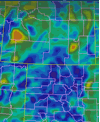|
The Forecast Systems Laboratory has been involved
in many of the activities celebrating the 50th anniversary
of the Department of Commerce Boulder Laboratories. Half of NOAA
Research's 12 laboratories are located in Boulder, Colorado, along
with three Data Centers, one Joint Institute, and the Denver National
Weather Service Forecast Office. Boulder is also home to part of the
National Institute of Standards and Technology (previously the Bureau
of Standards) and the National Telecommunications and Information
Administration (NTIA). The community events included public lectures
and demonstrations, a science festival, and a rededication ceremony.
For historical purposes, a special committee compiled a volume of
landmark papers published since the dedication of the DOC Boulder
Laboratories on September 14, 1954.
A lecture series on "Research, Invention,
Discovery: Now and Then" was cosponsored by the City of Boulder. FSL
director Dr. Sandy MacDonald presented a talk on "Making Better
Predictions for Tomorrow and 100 Years from Now." At a recent Science
Festival, meteorologists Tom LeFebvre and Dr. Joe Golden gave
presentations on "Weather Forecasting of the Future" and "Tornadoes
and Waterspouts," respectively. The public could also see
demonstrations of Science On a Sphere™, NOAA's new technology for
educating the public on the dynamic forces of nature that impact our
oceans, atmosphere, and land.
The important research at NOAA is documented
through thousands of published papers in the open literature. The 50
best papers to represent the most significant accomplishments over the
50-year evolution of the Boulder Laboratories were selected by the
Historical Publications Committee. FSL representation included
research papers on microbursts, flash floods, wind profilers, and
numerical weather prediction. Two papers by Dr. Fernando Caracena were
chosen as milestones in atmospheric science. One paper, published in
1977, confirmed the hypothesis that downbursts could threaten
aviation; it definitively showed that not only could cumulus
convection result in downdraft-induced damaging winds but it could
also bring down a modern jetliner. This paper paved the way for many
followup studies and field projects, and the construction of Terminal
Doppler Weather Radars at major airports and implementation of new
pilot training programs. Another paper published by Dr. Caracena in
1979 on his study of the Big Thompson flash flood was chosen because
this research awakened the meteorological community to the importance
of forecasting flash floods and opened the door to new programs and
research in the field. A paper written by Dr. Richard Strauch, Douglas
van de Kamp, et al. in 1984 described work that led to the deployment
of the NOAA Wind Profiler Network, which continues to provide
real-time wind data. Drs. Stan Benjamin and Tom Schlatter, Tracy L.
Smith, et al. published a paper in 1991 about FSL modeling technology
that made it possible to produce maps of surface and upper air weather
conditions and, from them, generate short-term forecasts at three-hour
intervals. The frequent updating of analyses and forecasts, which has
become the operational Rapid Update Cycle of today, led to improved
guidance for commercial flight planning and local weather
services.
Contact information
Name: Rhonda K Lange
Tel: 303-497-6045
Rhonda.K.Lange@noaa.gov
|





